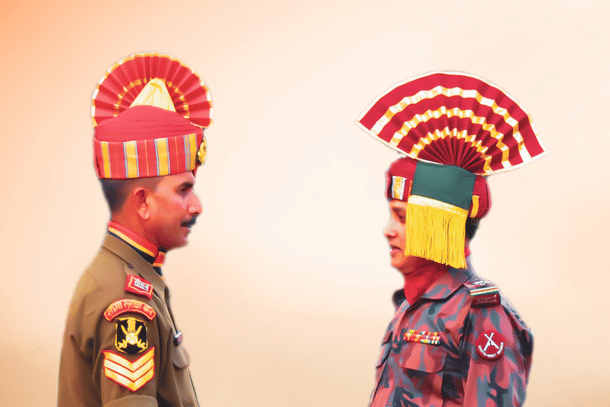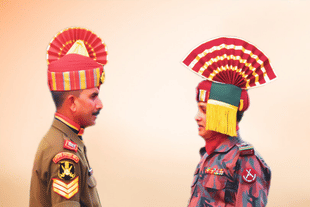World
Explained: Why Bangladesh Wants Its Border With India To Remain Porous And Unfenced
Jaideep Mazumdar
Jan 31, 2025, 12:29 PM | Updated Feb 11, 2025, 01:58 PM IST
Save & read from anywhere!
Bookmark stories for easy access on any device or the Swarajya app.


Bangladesh has a vested interest in keeping its 4,096.7-kilometre (km)-long land border with India porous and unfenced.
It wants smugglers, including cattle smugglers, to have unfettered access to India. And it wants its Muslim citizenry, especially the poor, to immigrate to India illegally.
Bangladesh, especially its border force — the Border Guards Bangladesh (BGB) — earns a lot from illegal cattle smuggling and from smuggling in foodstuff, cooking oil, medicines, and other commodities from India.
Bangladesh sends, apart from its Muslim citizens, narcotics, fake Indian currency, gold and other precious metals, arms, wildlife products, and antiques illegally into India through the border.
Bangladeshis, and various institutions in that country, like the BGB, earn huge sums of money from this illicit trade and smuggling, and from human trafficking.
And that’s why Bangladesh wants the Indo-Bangla border, the fifth longest land border in the world, to be open and porous.
This desire has become intense in recent months, after the fall of the Sheikh Hasina government in August last year.
One reason is that the interim government has come under the influence of Islamists, who want to send Bangladeshi Muslims into India to effect a demographic change in the country.
The aspiration for demographic change in India is driven by the Islamists’ ghazwa-e-Hind agenda (read this) that aims to make India part of a global Islamist caliphate.
As is well known, Muhammad Yunus, in order to stay on in power, has cut a deal with Bangladesh’s Islamists — in return for their support, he turns a blind eye to their extremist activities.
Pakistan, with whom he is trying to forge close ties, is also interested in effecting a demographic change in India, especially in Bengal and Assam, by pushing Bangladeshi Muslims into India.
Islamabad is learnt to have sold the idea to Dhaka that a demographic change in these two Indian states will pave the way for incorporation of the entire North East India into Bangladesh at some point of time in the future.
The BGB is an active accomplice in this scheme because of the bribes it earns from human traffickers, and also because of its recent Islamist leanings.
Bangladeshi human traffickers charge every individual who wants to cross over to India at least 15,000 Bangladeshi Taka (equivalent to Rs 10,681) for facilitating their infiltration. From this amount, the BGB gets at least 5000 Bangladeshi Taka.
On an average, about 1,000 Bangladeshi nationals enter India daily. That generates an earning of at least 50 lakh Bangladeshi Taka for the poorly paid BGB every day, or 15 crore Taka per month for the BGB personnel posted along the international border.
That’s a lot of money for the BGB, whose personnel get paid a fraction of the salaries of their counterparts in India's Border Security Force (BSF).
Money, and huge sums of it, is also the reason why Bangladeshi authorities, including the BGB, want smuggling to go on unabated.
Bangladesh is a poor country, and the areas along its borders with India are steeped in poverty. Smuggling is the only major economic activity that provides a livelihood to lakhs of Bangladeshis living in the districts bordering India.
Cattle Smuggling
According to the BSF’s conservative estimates, about 20 lakh heads of cattle are smuggled out of India into Bangladesh every year. This estimate is based on the number of seizures (of cattle from smugglers) made by the BSF every year.
The actual figure is likely to be much higher. Cow protection activists say that as per their estimates, more than 26 lakh heads of cattle are smuggled into Bangladesh from India every year.
For every head of cattle smuggled into Bangladesh, the smugglers have to pay the BGB at least 10,000 Bangladeshi Taka. That translates into an earning of a whopping 2,000 crore Taka for the BGB every year.
And then there are local politicians and police who also earn substantial sums as bribes from smugglers. The smugglers and their accomplices themselves make a profit of about 20,000 Bangladeshi Taka from every head of cattle.
It may be mentioned here that the difference in price for an adult, healthy cow between India and Bangladesh is about Rs 25,000 (more than 35,000 Bangladeshi Taka). This difference goes up during festivals like Eid, when the smugglers make a killing.
Smuggling of Other Commodities to Bangladesh
The earnings from smuggling foodstuff, cooking oil, medicines, and other items, including cough syrup, are also quite high.
Just last weekend, the BSF seized 62,200 bottles of phensedyl (a cough syrup used as a drug) from an area along the Indo-Bangladesh border in Bengal’s Nadia district. The entire haul is valued at around Rs 140 lakh.
“We were lucky with this seizure. But every year, lakhs of bottles of this cough syrup are smuggled out from India to Bangladesh,” a senior officer at the BSF’s South Bengal Frontier headquarters in Kolkata told Swarajya.
Add to this the tens of thousands of kilos of rice and cereals, as well as the huge quantities of salt, sugar, cooking oil, spices, and other items that are smuggled out of India, and the scale of the smuggling becomes clear.
Needless to say, the BGB earns substantial amounts from this smuggling as well. It is estimated that a BGB constable posted along the border, whose salary is a measly Rs 10,000 a month, gets at least another Rs 10,000 every month from the smugglers of his country.
It is estimated that the value of goods smuggled out of India to Bangladesh (excluding cattle) is nearly Rs 14,000 crore. Even if smuggling these goods into Bangladesh generates a profit of 10 per cent (a very conservative estimate), the amount would be Rs 1,400 crore, or nearly 2,000 crore Bangladeshi Taka.
Smuggling Into India
Last year, the BSF seized gold and silver worth Rs 13,000 crore that were being smuggled into India from Bangladesh.
The BSF also seized over 11,866 kilos of narcotics, fake Indian currency notes valued at over Rs 32.6 lakh, as well as arms and ammunition, that were being smuggled into India.
According to the BSF, seizures account for only 10 per cent of the goods and commodities, including livestock, smuggled between the two countries.
Others with a good ground knowledge of cross-border smuggling say this is a very conservative estimate.
However, even going by the BSF’s ‘conservative’ estimate, if the value of the seizures (of gold, silver, fake Indian currency, narcotics, and other items) in 2024 was about Rs 25,000 crore, it means that items worth over Rs 2.5 lakh crore were smuggled into India from Bangladesh.
Add to this the value of cattle smuggled out of India (Rs 8 lakh crore), as well as the other items that are smuggled into Bangladesh from India (Rs 14,000 crore), and one gets an idea of the scale and value of cross-border smuggling that goes on.
It is estimated that the value of cattle, foodstuff, gold and precious metals, narcotics, arms, and fake currency smuggled across the Indo-Bangladesh border would be more than Rs 12 lakh crore. That’s a little less than four times what Bangladesh earned from exporting garments in 2024.
Garments are Bangladesh’s prime export commodity, and the country earned $38.48 billion ($3,848 crore) from it last year. At current conversion rates, that comes to 467,072 crore Bangladeshi Taka, or Rs 331,740 crore.
There is yet another reason why Dhaka wants the Indo-Bangladesh border to remain porous and open. Bangladeshi criminals often commit dacoities in villages on the Indian side of the border and make a quick escape to their country with the booty. Theft of cattle from Indian villages by Bangladeshi criminals is also quite common.
Bangladeshis often steal standing paddy and other crops from farmlands on this side of the border. Abduction of Indian villagers for ransom also goes on at some places.
Apart from cross-border smuggling, these crimes are also a source of livelihood for many Bangladeshi criminals who get patronage from their local politicians, police, and the BGB.
The economy of vast swathes of Bangladesh’s border districts runs on smuggling and transborder crimes. That, as well as the agenda of pushing in Muslims from their country to effect a demographic change in India, is why Dhaka wants the Indo-Bangladesh border to remain open and porous.





